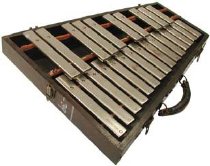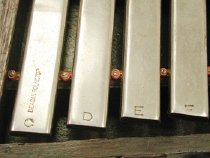Object Record
Images



Metadata
Catalog Number |
1993.01.11 |
Object Type |
Glockenspiel |
Creator |
J. C. Deagan, Inc. |
Title |
Deagan Round Top bells |
Description |
Deagan Round Top Bells, 2 octaves. Steel bars convex both top and bottom, high D to C showing much wear and corrosion. Bars rest on orange felt with original rubber spaces between. Bars held by screws inserted htrough hole in top of bar. Case has painted black hardware. Hinges on back, leather handle and two latches on front. One latch on left, corners reinforced with steel stip. No lid on exhibition. On Low C is stamped "DEAGAN ROUNDTOP". In Mid A, "A=440" and "JC DEAGAN, CHICAGO, PATENTED". In High A, "L". White paint on Low C#. |
Dimensions |
H-4 W-19 L-25 inches |
People |
J. C. Deagan, Inc. |
Additional Research |
Manufactured during the early decades of the 20th Century, the J. C. Deagan Company's "Roundtop" Orchestra Bells are considered the highest quality glockenspiels, or orchestra bells, manufactured. Constructed from the best steel available at that time, the instruments produce a long, sustaining tone with brilliant, penetrating dynamic contrast. The solid oak cases and quality of workmanship have allowed many of the instruments to continue in use to the present day. Deagan Roundtop Bells Chicago 1910 - 1920 The earliest of keyboard instruments made by the J.C. Deagan Company are its orchestra bells. This set of encased "roundtop" bells has a chromatic two-octave sounding range, beginning an octave above middle-C. Orchestra bells belong to the glockenspiel family of instruments and are noted for their bright, penetrating tone color. Paul Dukas uses the orchestra bells in his The Sorcerer's Apprentice, a piece well known from the soundtrack of Disney's Fantasia. PAS Museum Exhibit Label Deagan's Catalog "D" (ca. 1914) boasted that the "Roundtop" Orchestra Bells "have the best tone of any Bell in the world, and are very much easier to play than Flat Top Bells, owing to the fact that the top being slightly convexed, the full tone of the Bell is produced whether the Bell is struck at an angle or struck squarely, while the Flat Top Bells it is necessary to strike the Bell absolutely square in order to produce the full rich tone of the Bell. Owing to the peculiar shape of the Roundtop Orchestra Bell, all counter-harmonies or overtones are entirely eliminated, and when the Bell is struck nothing but the pure fundamental tone is heard. Owning to the fact that the tops of the Roundtop Bells are slightly convexed, there is no flat surface to reflect the light in the operator's eyes; a fault so common in Flat Top Bells. As the underside of the Roundtop Orchestra Bells are convexed, there is less surface of the Bells to come in contact with the supporting felt, thus leaving the Bell more free to vibrate." The bars were triple plated to prevent rust, and came in four sizes: 7/8 x 3/8 inch, 1 x 7/16 inch, 1 1/4 x 7/16 inch, and 1 1/2 by 1/2 inch. Each size of bar was available in 2-, 2 1/2-, or 3-octave ranges. They were available in either folding cases or in solid "flat" cases. This instrument is Model No. 1228, a 25-bar, 2-octave (C to C) instrument. The bars are 1 1/4 x 7/16 inch in size, mounted in a flat case. The case measures 18 5/8 inches at its widest end, and is 25 inches long. The list price in 1914 was $40.00. Percussive Notes, April 2005. Ranging from tinny toy instruments, to lyre shaped glockenspiels used in marching bands, to the round top bells found in orchestras, the glockenspiel is played in many different genres of music. This particular instrument remains one of the finest glockenspiels ever produced, still in demand a century after being manufactured. J. C. Deagan's exquisite round-top instrument has convex steel bars that produce pure, sustained tones that are ideal for orchestral use. Evolving Sounds, 2017. |
Credit line |
Gift of Carroll Bratman |
